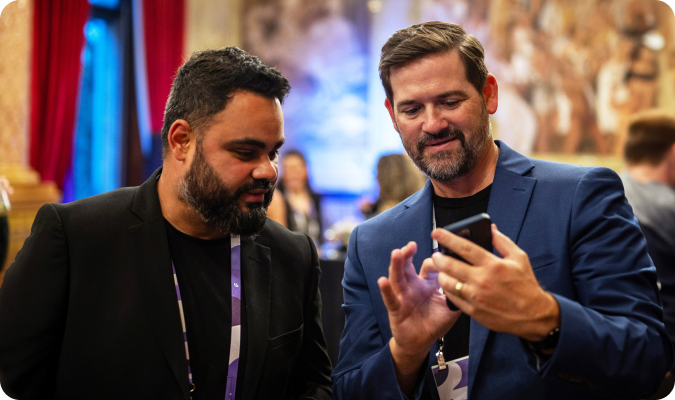
From marketing and planning, to event registration and attendee feedback, most event life cycles generate data (and a lot of it). But have you been wondering how to actually use this data in an event planning context? After all, amassing all that data would be a waste if you don’t have the capacity to analyze and gain insights from it.
This is where data analytics becomes important. In this article we’ll take an introductory look at how to use your data to maximize event planning and delivery.
Data, data everywhere
If you’re already collecting event data, there’s a good chance it remains scattered across a variety of different event management tools. You’re probably wondering how to consolidate your data into a single platform.
Data consolidation is a huge challenge, but a necessary one. Why? Because your data is only useful if you know how to analyze the data, then apply the insights to your context.
Using data and getting valuable insights can be a bit of a challenge, it’s far from impossible.
Now let’s take a deeper look at how data is used in event planning.
What is event data?
Event data is the raw information you collect about the people who interact with your events using technology platforms. Good data allows event planners to better understand their attendees across each stage of the event journey. Events data will help you paint a detailed picture of your attendees’ experiences, what they enjoyed and what can be improved for next time.
How is data analytics used in event planning?
Event planners can harness data analytics in a number of powerful ways. Most importantly, you’ll have greater insight into your audience’s needs and drivers; and will be able to make data-driven decisions to improve how you do things, such as the overall event experience. Let’s take a look at some examples of this now.
Personalize your event marketing
Today’s attendees expect personalization – and this means far more than simply putting names on invites. Data has made it possible for marketers and event organizers to engage in highly personalized event marketing tactics. Two great examples of this include:
- running targeted and segmented campaigns that are highly relevant to customers
- specific marketing campaigns based on online activity and preferences across the likes of Facebook, Instagram, LinkedIn or X.
When used correctly, data-driven personalized messaging can increase public engagement and awareness without breaking the budget. This means that data captured before an event can also give you actionable information. For example, who opened the invites and what actions did they take on-site aside from registration? Depending on how you use these data points, you can gather useful and actionable insights.
Increase engagement
Many people today say they value experiences more than material wealth. But until recently, we seemed to place quantitative data (the number of attendees, how long they stay) on a pedestal, with experiential or qualitative data being harder to measure and act on.
However, recent innovations in the digital space have made it possible to track and gain more insights from attendee experience. Online events produce more data, however that doesn’t mean live events are inferior from a data analytics perspective. Why? Because live events can capture more nuanced data than online ones, since you’re face-to-face with customers.
Event managers can use this to personalize experiences like broadcasting to nearby devices and connecting users through a geolocation-based app or event packets. This lets you create a 3D profile of your attendees, including their engagement level and emotional responses as they go through the event.
Another great strategy is to monitor how gamification activities are performing via metrics such as attendee statistics, points statistics, or goals completed. This gives you real-time confirmation on whether you need to take further action to drive attendee involvement; and ultimately increase overall engagement in areas that may be lacking.
Crowdshaping
If you deliver larger events, you may be wondering how you can leverage data to control the crowd flow. This is a powerful way to maximize attendee engagement. Today, a wide array of technologies like Bluetooth tags, RFID wristbands and interactive event apps are used to gauge and enhance the experience of event attendees. It can also shape how you manage a longer event, like lengthening the hours for a favored booth or event segment, or pushing sponsored content during peak times.
How else can you use this data at your next event? Consider the idea of managing staff and support personnel stations based on the crowd density. For example, you can put in another bartender at a popular bar stall, so customer needs are swiftly satisfied if the wait time is becoming too long. Crowdshaping applications can ensure your attendees are shaping the experience and enjoying their time, rather than you having to shepherd them from place to place.
Tailoring experiential marketing
Experiential marketing is a powerful strategy that immerses audiences in live experiences. It provides a memorable experience and connects them more deeply with brands throughout the purchasing life cycle. Interactive displays and booths, live demonstrations, product sampling, photo opportunities and pop-up sessions are all great ways to incorporate experiential marketing into your event.
You can leverage your own data to create these experiences, or draw on data tracked from consumer conversations on social media. It can also be useful to include social media influencers (even micro-influencers) as part of this process.
Digitizing experiences
It goes without saying that the world of events has changed forever since 2019. It’s difficult to imagine that just four short years ago, the terms hybrid event and virtual attendees didn’t really exist – and now, they seem to hold the key to the very future of event management.
While this has been a challenging period for the industry, the move towards more digitized event experiences is a net positive one. Not only are event planners learning how to use event data to deliver more successful virtual events – it will also help to drive transformation of in-person events, as we introduce data-driven technologies such as AI, virtual reality and even augmented reality events.
Improved future experiences
Actionable feedback is what drives the event industry forward. Thanks to event data analytics, discovery surveys and post-event surveys on Facebook and other social channels are more personalized than ever. The whole event life cycle generates a ton of data that can be used in so many different way, for example:
- provide insights to shape future events
- discover new pain points and understand your audiences’ expectations of your event
- help you identify factors that might affect your attendees’ behavior.
While data may not reduce the number of twists and turns in a given event, it can reduce uncertainty and identify potential issues to give you more flexibility in events. With the right tools, data also lets you look ahead into the future – gaining insights on emerging trends and audience preferences. While an event might only give you ten leads, the amount of data you captured can improve your next sales cycle tenfold.
Once you understand how to leverage event planning data, you’ll find yourself making the most of each event life cycle. As more tools and use cases develop, data analytics will continue to drive forward efficiency and innovation in our industry.
How can our event technology and data solutions help to improve your next event?
At EventsAir, we understand the importance of selecting the right event technology partner – someone who can help turn your valuable data into information gold, and improve the overall experience for your attendees.
We have one simple mission: to help event planners deliver the WOW in their events with the world’s most powerful event management technology. We’ve delivered some of the world’s biggest events, and we’d love to help you too.
If you would like to understand how powerful event data can maximize your event planning and delivery then schedule a demo with one of our team members today.
Event Data & Analytics | Event Technology & Apps | Meetings and Events
See EventsAir in action
Discover why 12,000+ event professionals trust EventsAir to deliver effortless events, every time.




